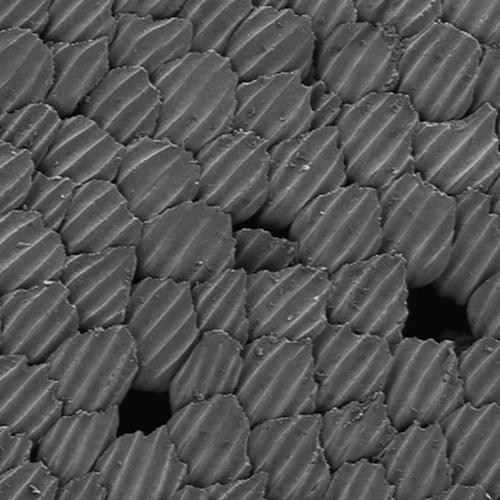当前位置:
X-MOL 学术
›
J. Morphol.
›
论文详情
Our official English website, www.x-mol.net, welcomes your feedback! (Note: you will need to create a separate account there.)
The denticle surface of thresher shark tails: Three‐dimensional structure and comparison to other pelagic species
Journal of Morphology ( IF 1.5 ) Pub Date : 2020-06-09 , DOI: 10.1002/jmor.21222 Meagan Popp 1 , Connor F White 1 , Diego Bernal 2 , Dylan K Wainwright 1 , George V Lauder 1
Journal of Morphology ( IF 1.5 ) Pub Date : 2020-06-09 , DOI: 10.1002/jmor.21222 Meagan Popp 1 , Connor F White 1 , Diego Bernal 2 , Dylan K Wainwright 1 , George V Lauder 1
Affiliation

|
Shark skin denticles (scales) are diverse in morphology both among species and across the body of single individuals, although the function of this diversity is poorly understood. The extremely elongate and highly flexible tail of thresher sharks provides an opportunity to characterize gradients in denticle surface characteristics along the length of the tail and assess correlations between denticle morphology and tail kinematics. We measured denticle morphology on the caudal fin of three mature and two embryo common thresher sharks (Alopias vulpinus), and we compared thresher tail denticles to those of eleven other shark species. Using surface profilometry, we quantified 3D‐denticle patterning and texture along the tail of threshers (27 regions in adults, and 16 regions in embryos). We report that tails of thresher embryos have a membrane that covers the denticles and reduces surface roughness. In mature thresher tails, surfaces have an average roughness of 5.6 μm which is smoother than some other pelagic shark species, but similar in roughness to blacktip, porbeagle, and bonnethead shark tails. There is no gradient down the tail in roughness for the middle or trailing edge regions and hence no correlation with kinematic amplitude or inferred magnitude of flow separation along the tail during locomotion. Along the length of the tail there is a leading‐to‐trailing‐edge gradient with larger leading edge denticles that lack ridges (average roughness = 9.6 μm), and smaller trailing edge denticles with 5 ridges (average roughness = 5.7 μm). Thresher shark tails have many missing denticles visible as gaps in the surface, and we present evidence that these denticles are being replaced by new denticles that emerge from the skin below.
中文翻译:

长尾鲨尾巴的小齿表面:三维结构与其他远洋物种的比较
鲨鱼皮肤细齿(鳞片)在物种之间和单个个体的身体上在形态上是多种多样的,尽管这种多样性的功能知之甚少。长尾鲨极其细长和高度灵活的尾巴提供了一个机会来表征沿着尾巴长度的细齿表面特征的梯度,并评估细齿形态和尾部运动学之间的相关性。我们测量了三只成熟的和两只胚胎的普通长尾鲨 (Alopias vulpinus) 尾鳍上的细齿形态,并将长尾鲨与其他 11 种鲨鱼的尾细齿进行了比较。使用表面轮廓测量法,我们量化了脱粒机尾部的 3D 细齿图案和纹理(成人 27 个区域,胚胎中的 16 个区域)。我们报告说,脱粒机胚胎的尾部有一层膜,可以覆盖小齿并降低表面粗糙度。在成熟的长尾鲨尾巴中,表面的平均粗糙度为 5.6 微米,比其他一些中上层鲨鱼物种更光滑,但粗糙度与黑鳍鲨、鼠鲨和帽头鲨的尾巴相似。中间或后缘区域的尾部粗糙度没有梯度,因此与运动幅度或运动过程中沿尾部的推测的流动分离幅度没有相关性。沿着尾部的长度有一个前缘到后缘的梯度,前缘细齿较大,没有脊(平均粗糙度 = 9.6 μm),后缘细齿较小,有 5 个脊(平均粗糙度 = 5.7 μm)。长尾鲨的尾巴有许多缺失的细齿,表面有缝隙,
更新日期:2020-06-09
中文翻译:

长尾鲨尾巴的小齿表面:三维结构与其他远洋物种的比较
鲨鱼皮肤细齿(鳞片)在物种之间和单个个体的身体上在形态上是多种多样的,尽管这种多样性的功能知之甚少。长尾鲨极其细长和高度灵活的尾巴提供了一个机会来表征沿着尾巴长度的细齿表面特征的梯度,并评估细齿形态和尾部运动学之间的相关性。我们测量了三只成熟的和两只胚胎的普通长尾鲨 (Alopias vulpinus) 尾鳍上的细齿形态,并将长尾鲨与其他 11 种鲨鱼的尾细齿进行了比较。使用表面轮廓测量法,我们量化了脱粒机尾部的 3D 细齿图案和纹理(成人 27 个区域,胚胎中的 16 个区域)。我们报告说,脱粒机胚胎的尾部有一层膜,可以覆盖小齿并降低表面粗糙度。在成熟的长尾鲨尾巴中,表面的平均粗糙度为 5.6 微米,比其他一些中上层鲨鱼物种更光滑,但粗糙度与黑鳍鲨、鼠鲨和帽头鲨的尾巴相似。中间或后缘区域的尾部粗糙度没有梯度,因此与运动幅度或运动过程中沿尾部的推测的流动分离幅度没有相关性。沿着尾部的长度有一个前缘到后缘的梯度,前缘细齿较大,没有脊(平均粗糙度 = 9.6 μm),后缘细齿较小,有 5 个脊(平均粗糙度 = 5.7 μm)。长尾鲨的尾巴有许多缺失的细齿,表面有缝隙,



























 京公网安备 11010802027423号
京公网安备 11010802027423号